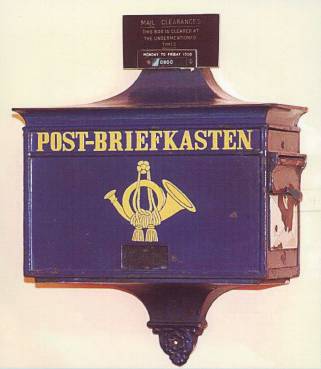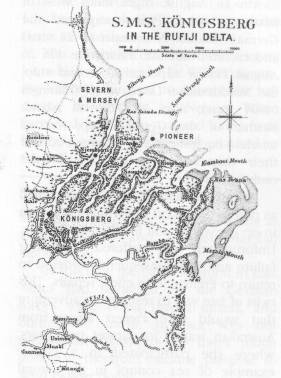- Author
- A.N. Other and NHSA Webmaster
- Subjects
- Ship histories and stories, WWI operations
- Tags
-
- RAN Ships
- HMAS Pioneer, HMAS Cerberus (Shore Establishment)
- Publication
- September 2005 edition of the Naval Historical Review (all rights reserved)

The wardroom of the Royal Australian Navy’s (RAN) premier training establishment, HMAS Cerberus, is home to many fine treasures reflecting Australia’s naval heritage. Perhaps the most curious of these is a dark blue enamelled iron postbox emblazoned in gold with the words Post- Briefkasten. This artefact was presented to the wardroom in 1916 by Lieutenant Commander R. C. Creer, RAN and has its origins in Bagomoyo, German East Africa.1 The story of how it became one of the most recognisable artifacts in the CERBERUS wardroom lies in the account of one of the RAN’s lesser-known warships, HMAS Pioneer, and the operations in which it was involved during the blockade of German East Africa in World War I.
The Royal Navy commissioned the 3rd class cruiser HMS Pioneer on 10 July 1900. Pioneer displaced 2200 tons and was armed with eight 4-inch single mount guns, eight 3 pounder guns and several machine guns. The ship also mounted two 14-inch torpedo tubes above the waterline. Pioneer first arrived in Australian waters in October 1905 and continued in service as a unit of the Royal Navy on the Australia Station until 29 November 1912 when she paid off at Sydney for transfer to the RAN as a gift from the Admiralty. Commissioned as HMAS Pioneer into the RAN on 1 March 1913, she was subsequently used as a seagoing training ship for the Naval Reserve.
When war with Germany was declared on 4 August 1914, Pioneer was in dry dock at Williamstown, Melbourne. Within 24 hours of the declaration of war the ship was afloat, provisioned, coaled and ready for sea. The following day she sailed for Fremantle, from where she patrolled the waters off the West Australian coast.
On 16 August, eight miles west of Rottnest Island, Pioneer captured the German steamer Neumunster (4424 tons) and escorted her into Fremantle. On 26 August Pioneer captured a second ship, the Norddeutcher-Lloyd vessel Thûringen (4994 tons), also off Rottnest Island. Neither of the German ships carried wireless equipment and it transpired that their masters were unaware of the outbreak of war.
In early November 1914, Pioneer sailed as part of the escort to the first Australian troop convoy bound for the Middle East. Unfortunately she suffered condenser failure and was consequently ordered to return to Fremantle to effect repairs. This twist of fate was to result in an adventure that would take Pioneer away from Australian waters for almost two years, where she participated in a classic example of sea control in the littoral environment.

On 24 December 1914, the Admiralty requested the urgent aid of Pioneer to take part in a blockade off the German East African coast. In September the German light cruiser Königsberg, mounting ten 4.1-inch guns, had engaged and destroyed Pioneer’s sister ship, HMS Pegasus, and had skilfully manoeuvred herself approximately 12 miles upstream in the shallow Rufiji River delta, in German East Africa, beyond the range of effective fire from the sea. The British forces assembling off the African coast were now faced with a double duty: first, the maintenance of a blockade to prevent supplies reaching German land forces in East Africa; and, second, the neutralisation of a dangerous German raider.
Pioneer sailed from Fremantle on 9 January 1915 and joined the British force off Zanzibar on 6 February. The force consisted of the light cruisers HMS Weymouth and HMS Hyacinth, HMS Pyramus (another of Pioneer’s sister ships), the armed merchant cruiser HMS Kinfauns Castle and six smaller vessels. Formal blockade was proclaimed on 1 March 1915, and five days later Vice Admiral Sir H. G. King-Hall arrived in the old battleship HMS Goliath to take charge.
For the purpose of blockade operations, the East African coastline was divided into three sections. Pioneer was ordered to patrol the northernmost of these and was appointed in charge of the Kinfauns Castle, the armed steamer Duplex and the whaler Pickle. There was little traffic to be watched, except for native dhows creeping along the coast, but signal activity by the enemy gave the impression that the Königsberg would soon make her bid to break through the blockade.




